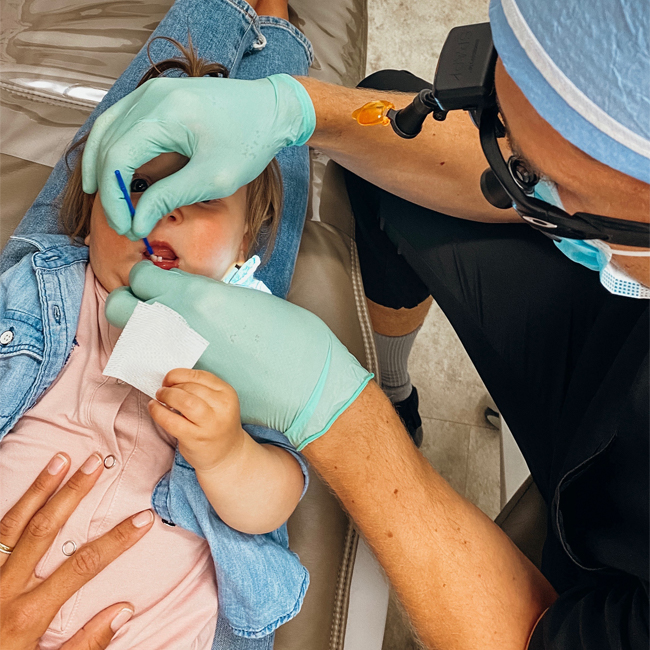We all have teeth. Well, most of us have teeth, or at least some teeth, but that doesn’t mean we have any idea what to do with our kid’s teeth, or baby’s gums, for that matter. I would speak just for myself, but when I put this ask out to most of you, I realized we all have many questions when it comes to our children’s dental health. Luckily, I knew exactly the person to ask to help us with all our queries.
I had the pleasure of meeting Ashley in 2013 in Oklahoma! Since then, I’ve enjoyed following along with all of her life adventures – she is a wonderful human, a wonderful wife, a wonderful mother, and very importantly, for our discussion today, a wonderful dentist!

Hi Ashley! Thanks so much for agreeing to help all of us parents out with our dental health questions! Can you start by telling us a little about you – your family, your dental background, and why you love teeth?!
Thanks for having me, Lauren! I love sharing my knowledge and passion for teeth!
A little about me… I received my Doctorate of Dental Medicine from the University of Saskatchewan in 2017. It was in dental school where I also met Jeremy, my husband. We got married in 2018 and became parents to our baby girl in 2019. Currently, we both work as dentists at a clinic in my Saskatchewan hometown. I love teeth because I love seeing people smile! There is nothing more rewarding than giving someone the confidence and comfort to truly smile. As a new mom, I’ve also learned that navigating parenthood is hard… I want to help educate parents to feel confident with their children’s oral health.
At what age should babies see the dentist for their first visit? Any recommendations on how to find a good dentist for your child?
The Canadian Dental Association (CDA) recommends bringing your child to the dentist 6 months after their first tooth erupts, or by age 1. It seems early, but it is very important to get your child used to being at a dentist, and even more important for that first visit to be a positive one! At this appointment, the dentist will assess your child’s risk for decay (cavities), look for developmental abnormalities or delays, and answer any questions based on your child’s personal habits (ie. pacifier use, thumb sucking, bottle use, brushing, flossing, etc.) This early visit helps build your child’s comfort in a dental setting. We don’t want you to wait until there is a problem – prevention is key!
On Instagram, lots of parents shared stories about their toddlers not letting them brush their teeth, even with the toddler’s brushing technique being very limited. Any advice for parents on what to do if this is their situation?
Don’t feel discouraged, you are not alone. Continue making brushing part of your routine. Every morning and every night, brush those teeth as best you can! With more exposures, your child will become more comfortable with brushing. Try laying them down – it’s easier for you to see, their muscles are less tense, and you have more control. If that’s a struggle, you may need a second person to help you brush by holding their hands and distracting them. Try making brushing fun – read books about brushing, sing songs to them while brushing, cuddle or tickle them while brushing – it doesn’t have to be a chore to brush! Also try including them. If they want to help, have them hold their own toothbrush in addition to the one you’re holding and they can brush after you’ve done a thorough job (they need help brushing until they can tie their shoes on their own). Let them pick which brush they want to hold, or let them decide which flavor toothpaste they want to use. Let them see you brushing your teeth – lead by example! It won’t always be easy, but just keep brushing. Brushing is way easier than having dental work done!
When should parents start using a baby toothbrush on their little ones? And how often should they be brushing? Along those lines, if a child doesn’t have any teeth yet, should parents be washing their gums?
We want you to start using a soft bristled tooth brush as soon as those little teeth erupt. Aim for brushing twice a day, but nighttime brushing is most important. Before your baby gets teeth, definitely wash their gums at least twice a day. You can use a warm wash cloth while they are still a sleepy newborn, and then switch to a silicone finger brush when they become a little more alert. Not only is this important to keep their oral tissues healthy, but it also helps get your baby more comfortable with brushing when they do get teeth.

Do you have a favourite toothbrush, toothpaste, and floss for babies/toddlers/kids?
For babies, any silicone finger brush is great. When your baby can hold things, switch to a soft silicone brush (the Baby Banana toothbrush is great, because it also seconds as a teether!). When teeth come in, a soft bristled toothbrush is next. I use the FridaBaby Smile Frida toothbrush for my daughter, because it has a triple angled brush that cleans all sides of the teeth at once. When brushing is established, you can switch to an electric toothbrush, if desired. Lastly, change their toothbrush when the bristles become frayed or after your child is sick.
Toothpaste is a personal choice. There are so many different brands, ingredients, flavors, and personal preferences. But this can be great, because you, as a caregiver, can make the best choice and fit for your family, along with your dentist’s personal recommendations.
Floss is pretty boring – any floss will do a great job! If you are able to successfully floss your child’s teeth, keep doing what you’re doing!
When should children start using toothpaste? And what is your take on fluoride versus no fluoride?
The CDA suggests that from birth to 3 years, the use of fluoridated toothpaste be determined by your child’s personal risk for decay. Your child’s decay risk is determined by your dentist. If your child is at risk for cavities, a smear (think, rice-size) amount of fluoridated toothpaste is recommended. If a low-risk for cavities exists, only water is recommended. However, sometimes fun toothpaste flavors can help your child become more motivated to brush. For example, my daughter has a low-risk for decay, therefore, only water is recommended. But, I personally decided to use a non-flouridated xylitol “banana” flavoured toothpaste, because she likes the flavour, and it keeps her motivated for brushing!
For ages 3+, fluoridated toothpaste is always recommended (ages 3 to 6-years-old, use only a pea-sized amount of fluoridated toothpaste under adult supervision).
Fluoride makes teeth more resistant to cavities and can even stop cavities from progressing further. If you are uncomfortable with fluoride, see your dentist early and often!
What’s the best flossing technique for a toddler?
Once your child has 2 teeth that touch, it’s time to start flossing! This usually happens around ages 2 to 3, but you can start much earlier to get your child used to it. You should floss your child’s teeth for them until they are 8 to 10-years-old (until then, they don’t have the manual dexterity to do it properly). There are a few flossing techniques. You can use traditional spooled floss and wrap around your fingers, and then use your index finger and thumb to gently move the floss between your child’s teeth (try doing this with your child laying down, if you’re struggling). Another option is floss holders. Floss holders can be easier to use and come in fun colors and flavours, but they can be pricier. Water floss/water piks are another option, especially for wiggly kids, but they may not effectively remove all the plaque. If you are unable to floss all the teeth in one sitting, try rotating the location where you start flossing each night, until your child becomes more comfortable with flossing. If your child likes to bite while you floss, give them a toothbrush to bite on while you floss. Much like with brushing, make flossing a regular part of your routine, and try to make it fun (songs, books, etc). It won’t always be easy, but it is necessary!
After babies/toddlers have their teeth brushed, is it okay to nurse them or give them a bottle?
Ideally, no food or drink would be consumed after you have brushed your child’s teeth for the night. But I know that it can be unrealistic to brush your baby’s teeth at 2 am after a nursing/feeding session! If your child is still feeding in the night, brush their teeth extremely well before bed to make sure there is no food/milk left on their teeth. Also, a quick wipe of the mouth with a cloth after the nighttime feeding is better than nothing. Then in the morning, brush those little teeth well, again!
Looking ahead to older kids, what’s your recommendation for how often they should be brushing and flossing?
We want to be brushing twice a day (morning and night), and flossing once per day (once your child has 2 teeth that touch). We recommend flossing for about 2-3 minutes before brushing, to get all the debris out. I usually floss before the bedtime brush routine. If you don’t floss, you are leaving over 30% of their teeth and gums untouched for bacteria to live and grow!
Do you have any recommendations on how to find a good dentist for your child?
My favourite way to get patients is through word of mouth. I love making connections with people, and for those people to want to share their experiences with family and friends. Another way is to search for family dental offices in your area and check out their website. It will often say if there is a dentist available who has experience working with children. In larger cities, there are usually paediatric dental offices available as well. Do what works best for your family, and find someone who makes you and your child(ren) feel comfortable.
Is there anything else you want to add?
A common misconception is that baby teeth aren’t important, because the child will lose them anyway. This is inaccurate! These baby teeth are holding space for future adult teeth. Early loss of baby teeth can cause future crowding issues in the permanent teeth. Also, poor oral health can negatively affect your child’s overall health. Please take care of those precious baby teeth!
Lastly, are there any social accounts or resources where people can find you?
I’ve come to learn that there aren’t nearly enough resources for parents to gain information on oral health care. I would love to create a resource to change that, whether that be a tooth dedicated Instagram account or a blog. For now, you can follow my personal Instagram account @ashleysvenkeson – I will share dental tips to help parents navigate oral health care for their children (I have a highlighted story). I love being able to offer you perspectives from being both a dentist and a mama. Thanks so much for listening. Keep smiling!
Ashley, I learned so much from talking to you. Thank you for being so thorough, as well as giving us so many great tips and examples. Your information will be so helpful in this area that is not most parents’ expertise!

